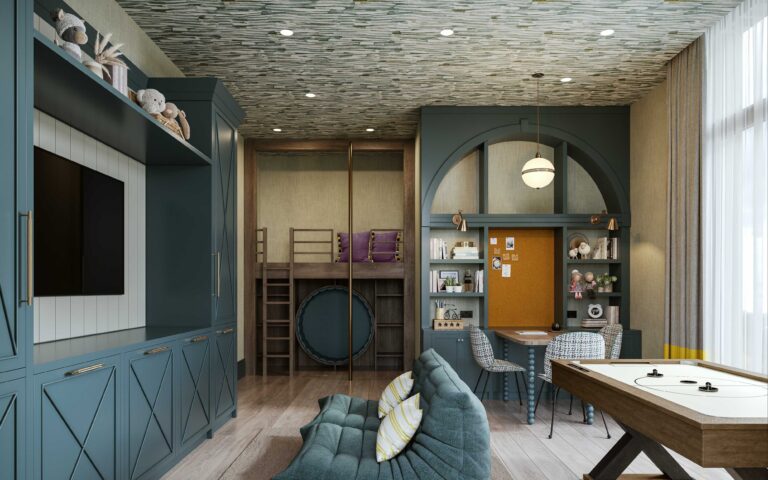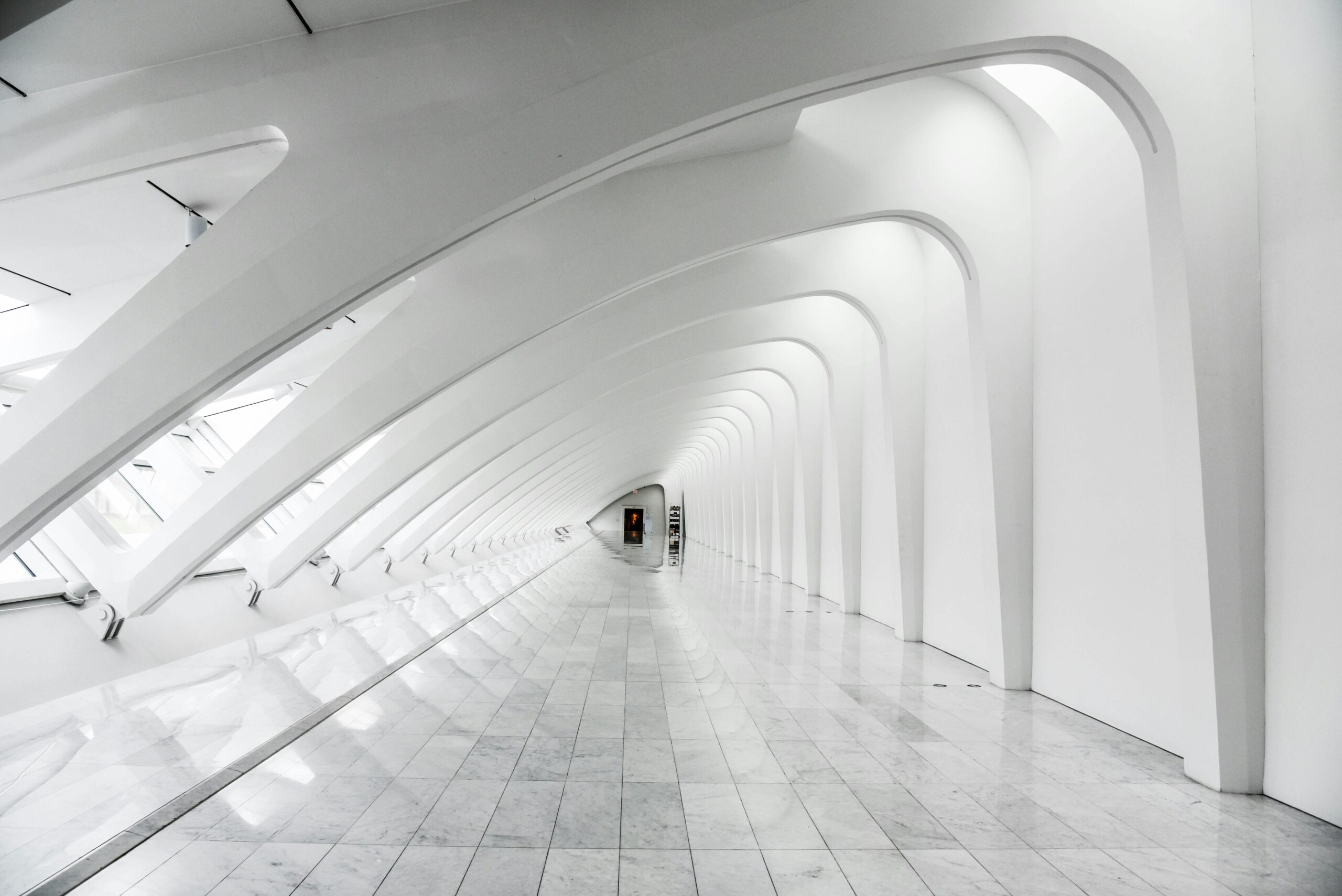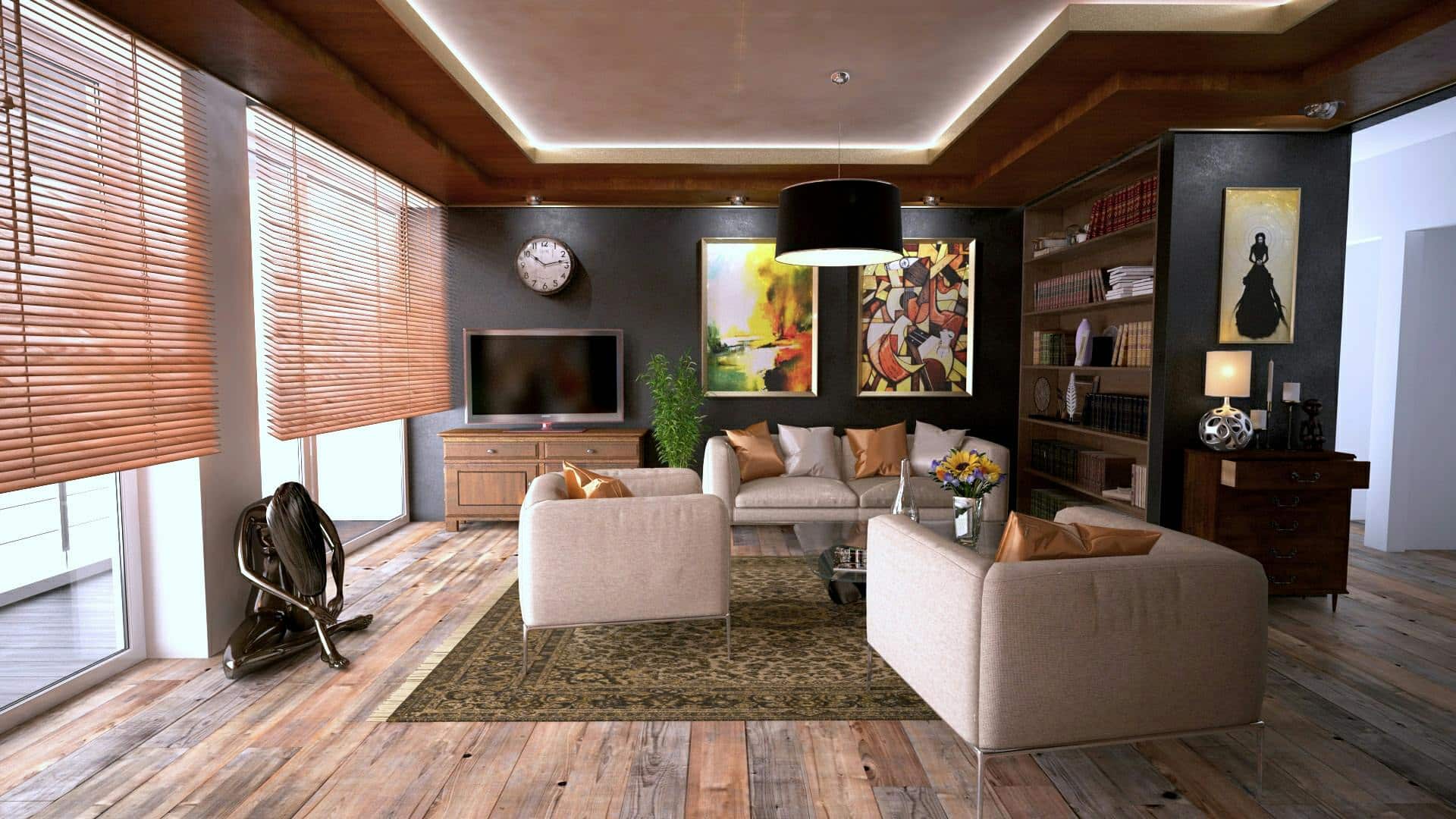Pictures of incomplete homes do not appear spectacular, and designs are difficult to grasp, so 3D Visualization in Pre-Selling Real Estate can be a powerful tool.
In other words, these ‘outdated’ technologies cannot be effective in situations when you need to stand out from the crowd or get an advantage over rivals. Here’s where 3D interior rendering services come in.
What is a 3D Visualization?
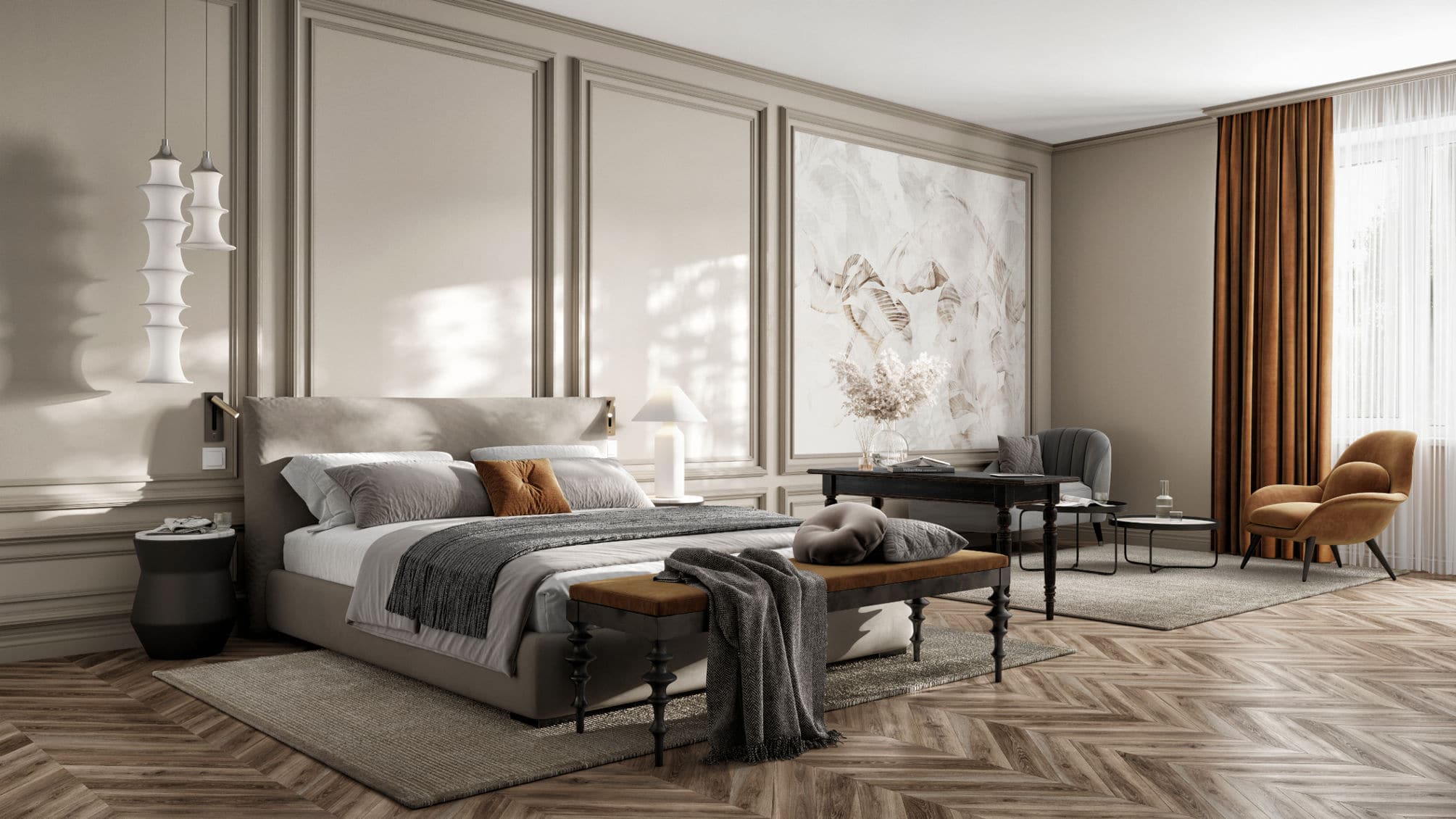
3D visualization is the process of making graphical representations of objects, situations, or surroundings in three dimensions. It entails creating pictures that look three-dimensional, allowing viewers to see depth and perspective.
This technique is widely employed in a variety of sectors, including architecture, interior design, product design, video games, cinema and animation, engineering, medical, and scientific research.
In 3D visualization, computer software is often used to produce and modify 3D models, which are virtual representations of actual things or settings. These models may be created using a variety of approaches, including polygonal modelling, spline modelling, and procedural modelling.
After the models are produced, they may be textured, lighted, and animated to provide realistic or stylized visuals. Advanced rendering techniques like ray tracing and global illumination are frequently used to create high-quality pictures with realistic lighting and shadows.
Overall, 3D visualization is an effective tool for visual communication, allowing designers, architects, engineers, and artists to present ideas, thoughts, and projects in a captivating and realistic manner.
The Evolving Landscape of 3D Visualization
Recent years have seen amazing developments in 3D visualization technology, notably with the incorporation of virtual reality (VR), augmented reality (AR), and AI-powered renderers. These technologies are transforming the pre-selling process in the real estate business, offering potential buyers unparalleled levels of immersion and engagement while expediting the development of 3D visualizations.
Virtual reality (VR)

Virtual reality technology allows users to fully immerse themselves in a virtual world, resulting in a more realistic and participatory experience.
In the real estate market, virtual reality is used to provide virtual property tours that allow potential buyers to explore every area of a house as if they were physically present.
VR headsets immerse viewers in a digital depiction of the property, delivering scale, dimension, and perspective that typical 2D representations cannot equal.
VR tours provide an unrivaled degree of involvement, allowing consumers to imagine themselves living or working in the place and making better-informed purchases.
Augmented Reality(AR)

Augmented reality projects digital material onto the actual environment, which is often viewed using a smartphone or tablet camera.
AR technology improves the pre-sales process by letting potential buyers see how a home would look in its actual location.
AR apps allow users to aim their device’s camera to an empty lot or construction site and view a virtual version of the proposed structure or development layered on the actual environment.
AR also supports interactive elements like pop-up information panels, virtual furniture placement, and customizable design options, giving customers a more personalized and immersive experience.
AI-Powered Rendering Tools
Artificial intelligence (AI) is widely used to automate and improve the rendering process in 3D visualization projects. AI-powered rendering technologies use machine learning algorithms to analyze incoming data and produce photorealistic pictures more quickly and accurately.
These programs may automatically modify lighting, texturing, and other visual components based on factors including time of day, geographic location, and user preferences.
The Significance of 3D Visualization
In today’s increasingly complex world, 3D visualization plays a pivotal role in enhancing comprehension across various fields, from architecture and engineering to medicine and education.
By transforming abstract concepts into tangible representations it enables more effective communication, problem-solving, and decision-making, ultimately driving innovation and progress.
Enhancing Communication and Understanding
3D visualization is critical for improving communication and comprehension across a wide range of sectors. By offering accurate and immersive representations of things, locations, and concepts, stakeholders may better understand complicated ideas.
Whether it’s architects showing architectural ideas, engineers exhibiting product prototypes, or scientists visualizing chemical structures, 3D visualization helps team members, clients, and partners communicate more clearly.
Streamlining design and development processes

3D visualization helps to expedite design and development processes in sectors like architecture, product design, and manufacturing. Designers may develop virtual prototypes and iterate on them quickly, eliminating the need for actual prototypes and decreasing the time and expense involved with modifications.
This iterative technique enables more efficient design exploration and optimization, resulting in superior final products.
Facilitating Decision-Making
In many professions, judgments must be made based on visual representations of prospective outcomes or designs. 3D visualization gives decision-makers realistic representations that help them analyze possibilities, evaluate alternatives, and make educated decisions.
Whether it’s picking a design for a new building, deciding between product variants, or planning a surgical operation, 3D visualization helps decision-makers by offering visual clarity and context.
Improving marketing and sales efforts
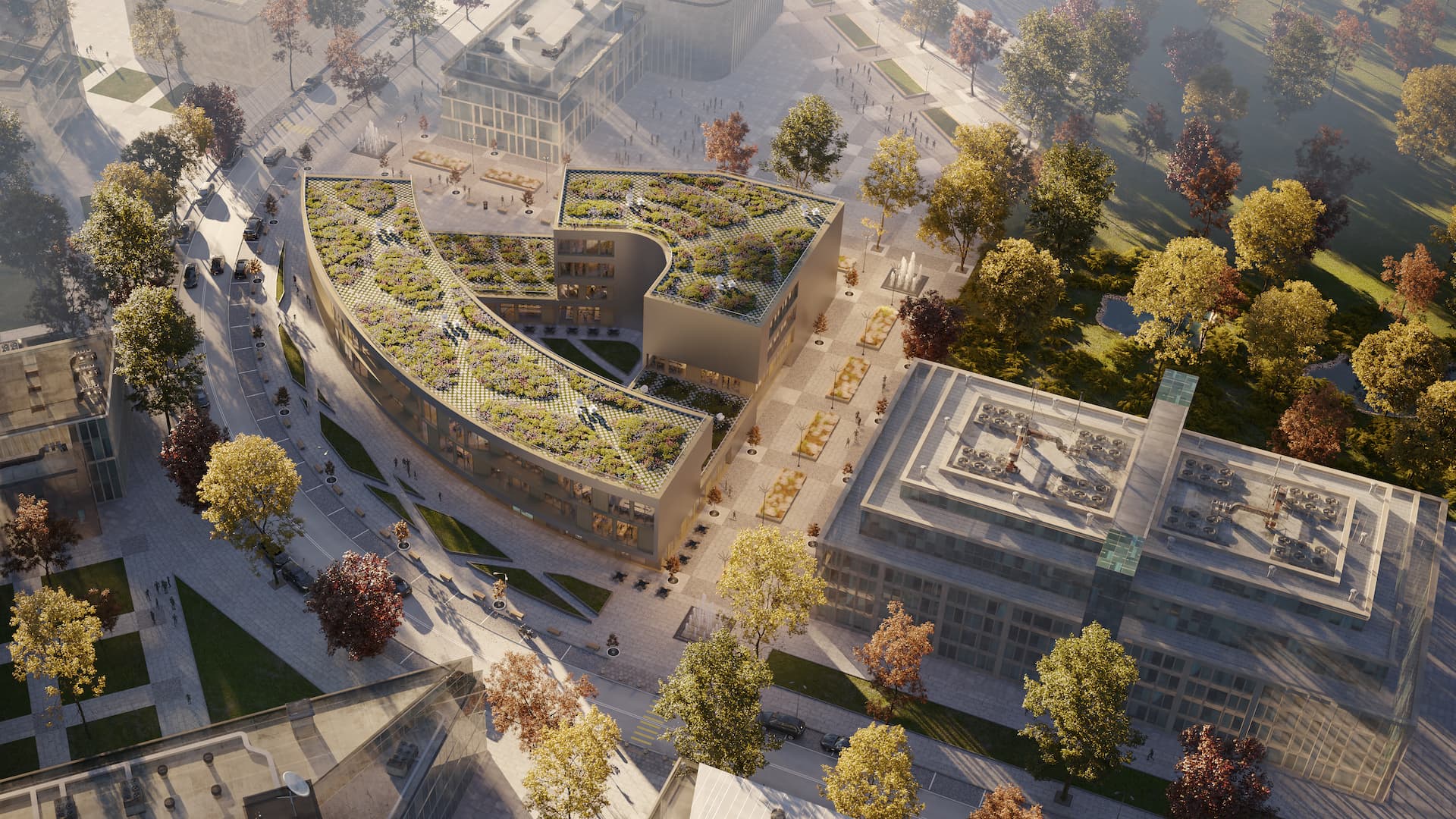
In businesses like real estate, interior design, and retail, 3D visualization is extremely useful for marketing and sales. High-quality renderings and animations assist to visually representing properties, goods, and concepts, appealing to potential consumers and clients.
Businesses may effectively market and sell their products by using lifelike images that highlight features and benefits.
Fostering Innovation and Creativity
Finally, 3D visualization promotes innovation and creativity by giving designers, artists, and researchers strong tools for exploration and experimentation. The capacity to visualize ideas in three dimensions promotes creative thinking and problem-solving, pushing the limits of design, art, and technology.
Whether it’s creating fanciful worlds in video games, planning futuristic architecture, or recreating complicated scientific processes, 3D visualization promotes innovation and development across disciplines.
The Impact of 3D Visualization on Real Estate Sales
In the area of real estate property, 3D visualization serves as a powerful device for charming capacity consumers before houses even hit the marketplace. By imparting immersive, realistic representations of houses and areas, it enables builders and marketers to showcase houses with remarkable clarity and detail, riding hobby, engagement, and, ultimately, pre-sales success.
Improved Accessibility
3D visualization makes properties more accessible to potential purchasers who are unable to see the real place owing to distance or other limitations. This broadens the pool of possible purchasers and improves the chances of securing pre-sales.
Reduced Marketing Costs
Compared to traditional marketing techniques like physical showrooms or print advertising, 3D visualization is a more cost-effective approach to promoting properties. Virtual tours and digital renderings may be shared online, reaching a larger audience for a fraction of the expense.
Better Collaboration
3D visualization makes cooperation easier for all parties engaged in the pre-selling process, including developers, architects, marketers, and purchasers. By offering a uniform visual language, everyone is on the same page and can successfully contribute to the project.
Environmental Sustainability
By lowering the need for physical showrooms and printed marketing materials, 3D visualization helps to promote environmental sustainability by reducing waste and energy consumption associated with traditional marketing methods.
Data Analytics
Digital marketing solutions designed for 3D visualization frequently include built-in analytics tools that give important information about customer behavior and preferences. This information can assist in shaping marketing tactics and optimize future pre-selling efforts.
Global Reach
With the internet and digital platforms, 3D visualization enables properties to be advertised to purchasers all over the world. This worldwide accessibility creates new markets and possibilities for developers looking to attract foreign consumers.
Collaboration and Iterative Feedback in 3D Visualization Workflow
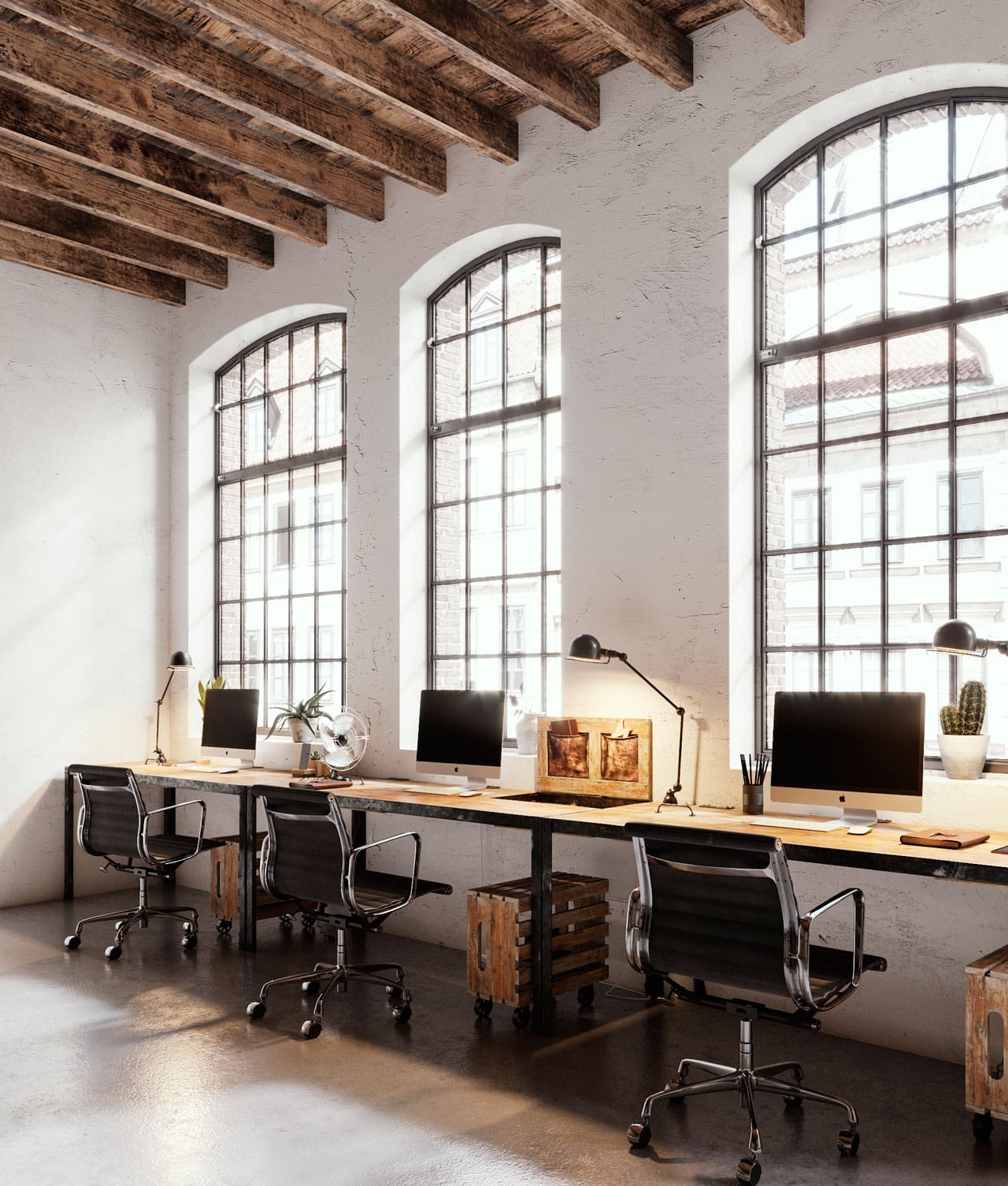
In the real estate industry, successful pre-selling campaigns rely largely on excellent coordination among developers, architects, and clients throughout the 3D visualization process. This collaborative approach guarantees that the final visualizations correctly reflect the client’s vision and needs, resulting in more attractive and persuasive marketing materials. Here’s why teamwork and feedback loops are important:
Clear Communication
Clear communication among all project stakeholders is the foundation of effective collaboration. Developers, architects, and clients must communicate their objectives, goals, and preferences from the start to ensure that everyone understands the project scope.
Iterative Design Process
The 3D visualization process should be iterative, with numerous rounds of feedback and adjustments. This iterative technique guarantees that the visualizations grow in response to user feedback, eventually refining and improving the final outcome.
Client involvement
Clients play an important part in the 3D visualization process since their input and comments shape the creation of the visualizations. Regular check-ins and presentations allow customers to examine their work, give feedback, and seek modifications as necessary.
Incorporating Feedback
Client, developer, and architect feedback should be actively considered during the design phase. Designers should carefully analyze each item of input and determine how to effectively apply it while adhering to the project’s goals and limits.
Quality Assurance
Regular quality assurance tests guarantee that the final visualizations satisfy the highest levels of quality and accuracy. Developers and architects should properly evaluate the visualizations before presenting them to clients, correcting any errors or inconsistencies that may develop.
So, the question is: how can real estate be pre-sold effectively?
Transformative Approaches to Selling: 3D Visualization in Pre-Selling Real Estate

In the realm of trade, selling isn’t always just a transactional process but a strategic undertaking. By exploring revolutionary tactics and powerful strategies, businesses can adapt to evolving market dynamics, interact with customers more meaningfully, and power sustainable growth.
Virtual tours and 3D visualiZations
Virtual tours and 3D visualization should be used to allow potential purchasers to view the house before it is built. This immersive experience creates a genuine feeling of the space, layout, and features, allowing consumers to imagine themselves living or working there.
Compelling Storytelling
Sell not only the property but also the tale that surrounds it. Highlight the development’s goal, motivation, and unique selling qualities. Whether it’s the architectural design, the history of the neighborhood, or the developer’s dedication to sustainability, telling a fascinating story gives the property depth and resonance.
Emphasize the benefits and value proposition
Focus on the property’s benefits and value proposition. Highlight important elements such as geographical benefits, facilities, possible ROI, and customization choices. Clearly state how the property fulfils the requirements and desires of the target market, emphasising the lifestyle benefits it provides.
Emotional Connection
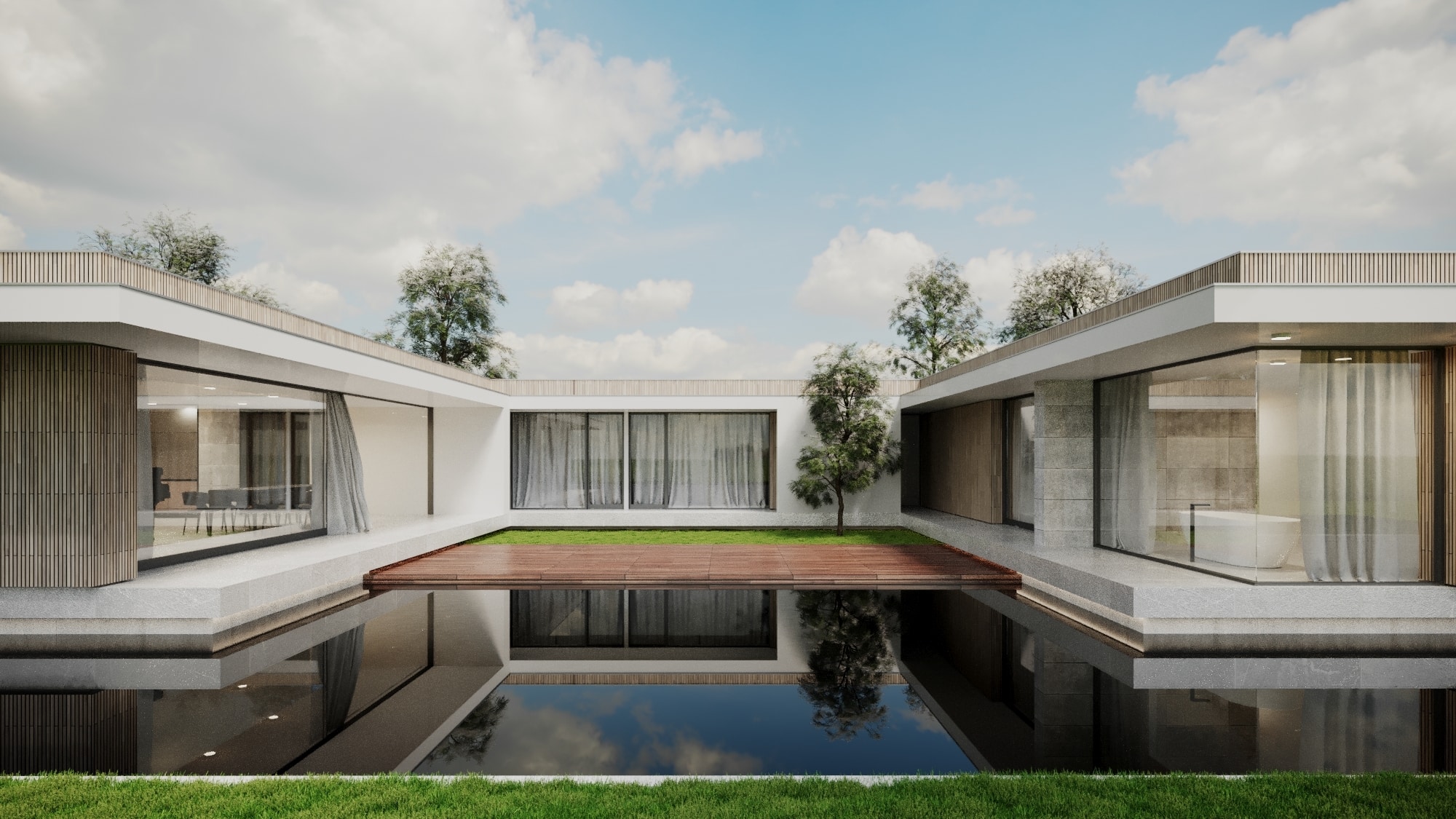
Make an emotional connection with consumers by appealing to their goals, hopes, and desires. Use compelling imagery, narrative, and personalization to elicit positive emotions and make the home appear desirable and aspirational. Showcase how living or investing in the property corresponds with the buyer’s goals and beliefs.
Flexible Purchase Options
Provide flexible buying alternatives to accommodate varied customer preferences and financial conditions. This might feature customizable floor plans, payment schedules in stages, financing alternatives, and incentives like early bird discounts or upgrades. Increasing flexibility increases the property’s accessibility and appeal to a larger group of potential buyers.
Justifying the Price with 3D VisualiZation
Use 3D visualization to justify the property’s pricing by displaying its worth and qualities in a visually appealing manner. High-quality renderings and virtual tours may showcase premium finishes, architectural features, and desirable facilities, allowing purchasers to understand why the property is valued the way it is. By providing a realistic representation of what consumers will receive for their investment, 3D visualization fosters confidence and trust, making the price appear justified.
Using the Power of CustomiZation
Empower real estate professionals to use the potential of customization with 3D visualization. Allow consumers to personalize their area by visualizing various design alternatives, finishes, and layouts. Virtual staging enables rapid and cost-effective experimentation with furniture placement and décor styles, assisting customers in visualizing their ideal home or workstation.
By allowing for customization, 3D visualization improves the buying experience and boosts the perceived value of the property.
Anticipated Trends and Innovations in 3D Visualization Technology for Real Estate
As 3D visualization technology advances, the real estate market will have access to new and fascinating applications. Here are some views into future trends and innovations that will most likely affect how properties are promoted, sold, and experienced:
Holographic displays
Holographic displays provide a futuristic approach to demonstrate features in three dimensions without the use of VR goggles or AR devices.
These displays generate lifelike holographic projections that appear to hover in midair, allowing prospective buyers to see houses from various angles and viewpoints.
Holographic displays have the potential to transform property showings and open houses, offering purchasers an immersive and memorable experience while minimizing the need for physical staging.
Virtual Staging
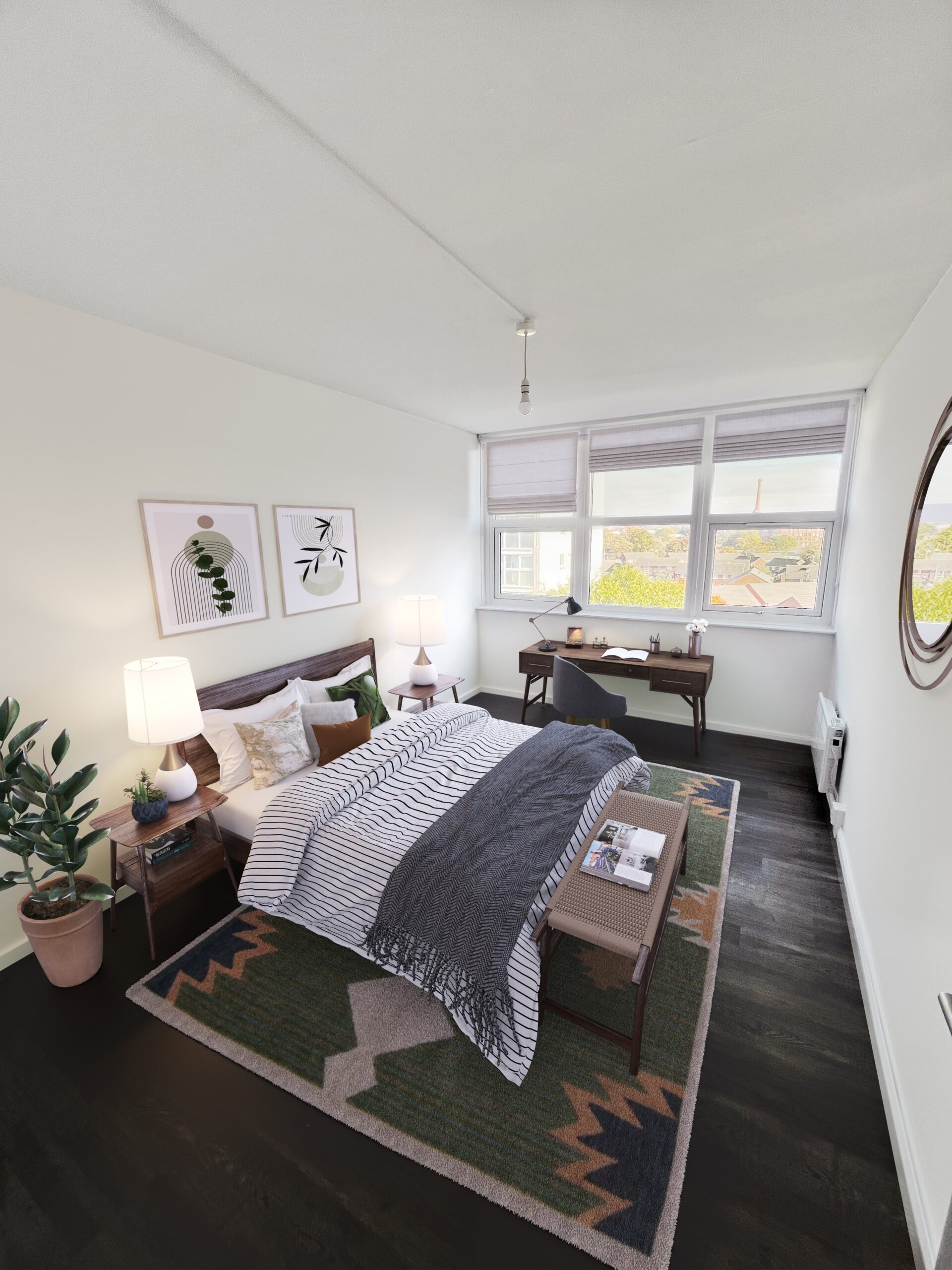
Virtual staging techniques will improve, allowing developers and realtors to digitally equip and decorate residences to appeal to a variety of buyer demographics.
AI-powered virtual staging systems may analyze buyer preferences and market trends to automatically propose furniture types, color schemes, and décor alternatives that will increase the property’s attractiveness.
Virtual staging will become a vital tool for pre-selling off-plan residences, allowing purchasers to visualize the possibilities of vacant spaces and personalize the interior design to their liking.
As in the image above, we have created a completely new look to an existing bedroom which was empty: we added furniture, carpet, flowers, cupboards and all other details to make this space alive and welcoming. This helps in the pre-selling stage to attract many more clients than simple empty apartment images.
Wrap up: 3D Visualization in Pre-Selling Real Estate
3D visualization transforms the way real estate is promoted and sold, particularly in the pre-construction period. Using innovative technology such as virtual tours and appealing narratives, developers, and realtors may effectively communicate the worth and potential of properties to potential purchasers. Emphasizing benefits, establishing emotional connections, and providing flexible buying alternatives all contribute to the property’s desirability.
Furthermore, 3D visualization justifies the price by graphically demonstrating the property’s value and enables customization, allowing consumers to imagine their ideal house or office. By tackling pre-selling difficulties like market instability and fluctuating customer preferences, 3D visualization emerges as a potent tool for increasing sales and staying ahead of the competition in the real estate business.
It not only simplifies operations, but it also encourages innovation, creativity, and informed decision-making across industries. As technology advances, 3D visualization’s importance in determining the future of real estate sales and marketing becomes increasingly clear.
Frequently Asked Questions: 3D Visualization in Pre-Selling Real Estate
Q. What if I cannot attend a physical inspection of the property?
Not a problem! Our virtual tours and 3D visualizations which you can upload on your website or social media accounts offer an immersive experience, allowing you to explore the property from the comfort of your own home. You may wander around each area, inspect features up close, and get a complete feel of the location without ever entering.
Q. How does 3D visualization assist justify the property’s price?
By graphically displaying the property’s features, finishes, and facilities, 3D visualization assists purchasers in understanding the value they are receiving for their investment. High-quality drawings and virtual tours showcase the property’s luxury features, making the price appear justified.
Q. How long does it take to finish a 3D visualization project?
The timescale for a 3D visualization project varies according to the property’s complexity and amount of customization required. However, we attempt to provide high-quality solutions in a timely manner, keeping you informed and involved in the process. Usually it takes up to 10 working days to finish a complex exterior project and up to 5 working days to provide interior visualizations.
Q. What if I have special design preferences or ideas for my property?
We welcome your feedback and suggestions! Our staff will collaborate directly with you to fully grasp your vision and preferences, ensuring that the final 3D visualization matches your own style and needs.
Q. How can I get started pre-selling a house using 3D visualization?
Getting started is simple! Simply contact our staff to discuss your project and requirements. We’ll guide you through the process and offer advice on how to use 3D visualization to effectively pre-sell your house.


